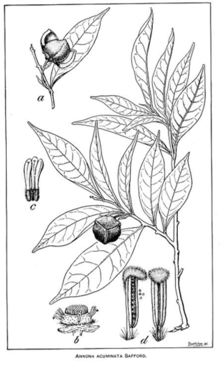| Annona acuminata | |
|---|---|

| |
| Scientific illustration of Annona acuminata | |
| Conservation status | |
 Least Concern (IUCN 3.1) | |
| Scientific classification | |
| Kingdom: | Plantae |
| Clade: | Tracheophytes |
| Clade: | Angiosperms |
| Clade: | Magnoliids |
| Order: | Magnoliales |
| Family: | Annonaceae |
| Genus: | Annona |
| Species: | A. acuminata |
| Binomial name | |
| Annona acuminata Saff. | |
Annona acuminata is a species of plant in the Annonaceae family. It is native to Panama, and Colombia. William Edwin Safford, the American botanist who first formally described the species, named it after the tapering (acuminatus in Latin) tips of its leaves.
Description
It is a tree reaching 5 to 7 meters in height. Its branches have numerous red-brown lenticels. Its oblong, membranous leaves are 6.5-8 by 1.8-2.2 centimeters and smooth on both surfaces. Its leaves taper to a distinctive tip which at its apex is rounded. The leaves have 10-12 pairs of secondary veins emanating from its midrib. Its petioles are 1.5-3 millimeters long. Flowers are solitary on 16-16 millimeter long peduncles. The peduncles, which are extra-axillary, have two distinctive, 2-4 millimeter long bracteoles, one at their base, and one near their middle. Its sepals are partially fused to form a broad-based calyx with three triangular tips. The outside of the calyx is hairy and the inside has stiff rust-colored hairs at its base. Its flowers have numerous 2.5 millimeter long stamens. Its flowers numerous ovaries arranged in a disc, each with a 1.5 millimeter long, club-shaped style. Its round, spiny fruit is 2-2.5 centimeters in diameter. Its yellow seeds are 7-8 millimeters long.
Reproductive biology
The bright orange-yellow pollen of Annona acuminata is shed as permanent tetrads.
Uses
Extracts of bioactive molecules from its tissues have been reported to contain aporphine derivatives.
References
- Erkens, R.H.J. (2021). "Annona acuminata". IUCN Red List of Threatened Species. 2021: e.T141028626A176443131. doi:10.2305/IUCN.UK.2021-3.RLTS.T141028626A176443131.en. Retrieved 20 June 2022.
- "Annona acuminata Saff". Plants of the World Online. The Trustees of the Royal Botanic Gardens, Kew. n.d. Retrieved December 22, 2018.
- Stearn, William (2004). Botanical Latin. Portland, Ore. Newton Abbot: Timber Press David & Charles. ISBN 9780881926279.
- ^ Safford, William E. (1913). "Annona sericea and its Allies". Contributions from the United States National Herbarium. 16: 263–276.
- Woodson, Jr., Robert E.; Schery, Robert W. (1962). "Flora of Panama. Part IV, Fascile 5 (Nymphaeaceae to Monimiaceae)". Annals of the Missouri Botanical Garden. 49: 137–255. doi:10.2307/2394708. JSTOR 2394708.
- Walker, James W. (1971). "Pollen Morphology, Phytogeography, and Phylogeny of the Annonaceae". Contributions from the Gray Herbarium of Harvard University. 202 (202): 1–130. JSTOR 41764703.
- Borup-Grochtmann, I.; Kingston, David G. I. (1982). "Aporphine Alkaloids From Annona acuminata". Journal of Natural Products. 45 (1): 102. doi:10.1021/np50019a011. ISSN 0163-3864.
External links
| Taxon identifiers | |
|---|---|
| Annona acuminata | |